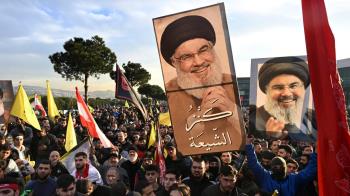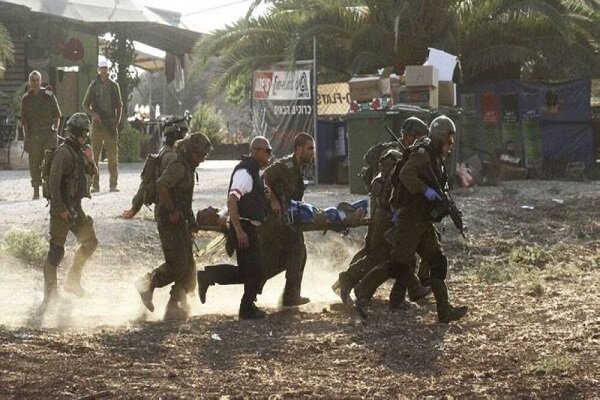Alwaght- Residents of Haifa had a horrific night under the missile and drone barrage of Hezbollah yesterday. The Lebanese resistance movement launched the highly accurate combined operation that dealt a fatal blow to the Israeli occupation forces in a deadliest attack against Israel since the beginning of war on October 8, 2023.
In the early hours of yesterday, the port city of Haifa in the occupied Palestinian territories was surprised by Hezbollah's missile and drone attacks, during which the Israelis have so far admitted the death of 4 soldiers and the wounding of dozens of other soldiers.
The army spokesman Daniel Hagari said in a statement: "Last night, a drone fired by Hezbollah bombed a military base near Benjamina."
He added: "In this incident, four soldiers of the Israeli army were killed and seven others were seriously injured, and the investigation of this incident continues."
The Army Radio, quoting a military source, reported that "Benjamina attack was carried out by a Hezbollah drone and is the deadliest attack since the beginning of the war."
In turn, Yedioth Aharonot newspaper quoted director of the Star of David relief group as saying that at least 39 people were injured in the Hezbollah attack on Benjamina in northern Israel, and three of the wounded are seriously injured, 5 others are seriously injured, and 14 soldiers are in moderate condition.
While the Israeli army has stepped its threats in recent days about land incursion into Lebanese territory and the occupation of border villages, Hezbollah's attack last night showed that the equations of complex war and the realities of the battleground are far from Israeli ambitions and wishes.
Hezbollah's high skill in bypassing multi-layer Israeli air defenses
One of the issues about last night's attack by Hezbollah was penetrablity of the multilayer air defenses of Israel including the much-vaunted Iron Dome that is developed at a high cost.
The weaknessees of this apparently advanced air defense system were disclosed several times by attacks of Axis of Resistance branches including those launched by Iran under Operation True Promise I & II, showing that the Israeli claims about capabilities of this system are far from reality.
However, even in the situation where the Israeli regime has concentrated a large part of its air defense power in the north to counter Hezbollah, the powerful movement has shown with successful drone operations that it is specially capable of outmanuvering the enemy's interceptors.
The Israeli army radio quoted a military source as saying that "air defense systems failed to detect the drones", adding: "investigations are underway to find out the reason."
Also, a military source, quoted by the Army Radio, suggested that Hezbollah succeeded in fooling the air defense system and fired a barrage of rockets to cover the drones.
Israel's Channel 12 also reported that the drones were launched towards Haifa under the cover of rocket barrage towards Galilee.
For its part, Hezbollah command center in a statement elaborated on the aspects of the operation, saying: "In a qualitative and combined operation, the Resistance's Missile Force fired dozens of missiles at various targets in Nahariya and Acre with the aim of engaging Israel's air defense systems. At the same time, the Resistance's Air Force launched a group of different drones, some of which were launched for the first time towards different areas in Acre and Haifa, hitting the intended targets."
The Jerusalem Post in a report, referring to the creative tactic of Hezbollah to confuse the Israeli air defense, said that the attack on Benjamina has laid bare the weakness of Israeli air defenses.
Israel's Channel 12 claimed that the drones completely disappeared from the radar after the initial detection, and the army no longer knew about their crash or continued flight, and for this reason, the alarms were not activated.
In recent years, Hezbollah has gradually shown the development of its drone power. Hezbollah has a variety of drones that are used for various purposes, including surveillance, intelligence collection, and suicide missions.
One of these effective drones is Mersad. It should be noted that the Mersad is a small UAV aircraft with a warhead of about 20 kilograms and can carry 40 kilograms of explosives and can fly at a height of 3,000 meters.
The Mersad-1 drone enables Hezbollah to conduct precision strikes deep into Israel, skipping the risks fighters may face in a ground penetration operation into Israel.
The Hezbollah's intelligence masterpiece
The site struck by Hezbollah was a Golani Brigade's training camp in Benjamina. Hezbollah attacked this military unit while it was a protected center and according to media reports, even the local residents were unaware of its existence.
It is also reported that this unit has been preparing forces to participate in a ground attack on Lebanon.
Hezbollah's intelligence was so accurate that the suicide drones hit the rooms where dozens of occupation officers and soldiers were present.
In the one year of Gaza war, Hezbollah has proven that it holds a very detailed and extensive database of the regime's military, strategic and economic centers in the far reaches of the occupied territories, and no activity is far from the sharp eyes of the monitoring of the movement.
Among the methods and instruments of data gathering, the drones are the most prominent and effective ones used in recent years. The most important surveillance drone is Hod Hod.
Having managed to captured accurate images of sensitive military, economic and strategic centers with its successful and secret penetration of the Israeli air defenses, this drone managed to conclude a reconnaissance mission over Haifa last Wednesday— an operation that appears to have stood as a prelude to the attack on the Golani elite unit.
Other examples of the depth of astonishment of the Israeli leaders about Hezbollah's detailed intelligence databases can be seen in September 24 operation, during which, according to Wala news website, Hezbollah's drones reached one of Israel's secret bases near Haifa.
The Israeli website declined to provide details on the nature of the military base, but Lebanese and Palestinian sources, citing Hezbollah's statement, reported that the drone attack targeted the command center of the special forces of the Israeli navy known as Shayetet 13.
Israeli vital arteries within Hezbollah's fire range
From another aspect, it should be taken into consideration that Hezbollah's successful operation has been conducted in the port city of Haifa which is one of the biggest and oldest ports of the occupied Palestine and also the most important port of the Israeli occupation that is also known as it economic artery.
Due to its deep-water quays, this port is always active throughout the year and it is also referred to as one of the largest ports in the Eastern Mediterranean. At the same time, it is described as the "Gateway of Israel's trade with the world" since 99 percent of the exports and imports of the Israeli regime take place through sea and Haifa has the biggest share in Israeli trade.
Certainly, given the high significance of this port, dense security and air defense layers guard it to avoid missile-caused damage during war. However, Hezbollah has shown that it is capable of outflanking Israel's multi-layer air defenses and subject one of Israel's economic pillars to danger of destruction.
This means that last night's attack carried messages of Hezbollah's capability to inflict damage on other Israeli vital economic centers like Ashdod and Eilat ports, or even Tel Aviv and Dimona nuclear reactor.
Currently, most of the regime's ports and airports are closed down or working partially, and finding safe ways to import goods to the occupied territories has become one of the main obsessions of the regime's leaders, because even if the ports are reopened, the Red Sea sea route is blocked by Yemen's Ansarullah Movement.
Hezbollah emerging powerful on the battleground
The operation against Haifa was indeed highly significant in terms of restoring self-confidence and assurance to the people of Lebanon, to the Hezbollah's fighters, and also to Hezbollah's regional backers and also significant in terms of maintaining the organizational structure of the movement and the field strength and stability of Hezbollah after assassination of Hezbollah leaders and some commanders commanders, especially Secretary-General Sayyed Hassan Nasrallah.
This operation proved to delusion-hit Israeli leaders and observers of Lebanon war that Hezbollah has not only managed to regain itself and break out of the initial shock caused by assassination of its leader Nasrallah and managed to make effective replacements both at organizational and field levels, but also it has departed from defensive mode and embraced an offensive mode, to the frustration of the Israelis.



























